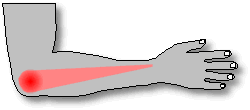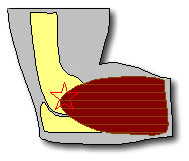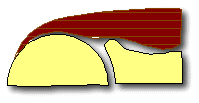| What is it? |
| Tennis elbow (also known as golfers elbow) is a type of painful tendinitis.
It results in pain on the outer side of the elbow
and forearm. Pain is usually aggravated by gripping and lifting with
the hand in certain positions. There may be swelling on the side of the
elbow. |
|
 |
|
| What caused it? |
-
Although tennis elbow can arise for no obvious reason, the most common
situation in which tennis elbow develops is following unaccustomed strenuous
activity involving the arm and hand.
Some of the stronger muscles involved with lifting and gripping attach
to the side of the elbow.
 
These muscles are connected to the bone through a tendon which looks
like a flat strap of gristle. The tendon is hard and pushes against the
side of the bone. It does not stretch or easily accommodate swelling, and
if irritated by sudden overuse, pressure may build up and cut off the blood
supply to the middle of the tendon. The tendon wraps around an area where
the bone sticks out, and pressure between this bone and the hard outer
layer of tendon may squeeze the inner parts of the tendon like a nutcracker:
 
Once this happens, the tendon may not be able to heal, or may heal
very slowly over many months. This slow healing may have to do with circulation,
but also because the area is stretched and twisted by normal movement of
the elbow, making it hard for irritated areas to rest. |
| What can you do to help? |
Ice for five to fifteen minutes at a time on the area which is most swollen
and tender.
"Over the counter" non-steroidal anti inflammatory medication (NSAID),
such as aspirin, ibuprofen, naprosyn, or ketoprofen. Check with your pharmacist
regarding possible side effects and drug interactions.
Avoid lifting with your palms down and elbow straight. The muscle which
is usually the most irritated (the extensor carpi radialis brevis) bends
the elbow and pulls the wrist back. When you lift something with
your palm down, you use this muscle, and when your elbow is straight, it
puts much more stress on the irritated tendon.
A splint or brace which supports the wrist.
Wait and watch.
|
| What can a therapist do to help? |
Provide a forearm strap or wrist brace to help protect the irritated area.
Help identify aggravating activities and suggest alternative postures.
Massage, heat, ice and other treatments aimed at making the area more comfortable.
Supervise a set of progressive exercises designed
to gradually strengthen and recondition the irritated muscles.
|
| What can a doctor do to help? |
-
Confirm that this actually is the problem.
-
Prescribe stronger NSAID medication or cortisone type medication.
-
Prescribe hand therapy and/or a custom prescription splint.
-
Give a cortisone shot into the sore area.
-
Perform surgery to remove the chronically irritated tissues, possibly shave
down the bone, and possibly cut some of the small nerves which transmit
pain signals from the area. The goal of surgery is pain relief, and
there are several different operations currently performed for this problem.
  |
| How successful is treatment? |
-
Simply waiting and watching may provide satisfactory relief in as many
as 4 out of 5 people, although often pain persists for months before resolving.
A specific supervised therapy program may improve results and speed recovery.
Recovery without surgery is less likely when the problem has developed
after a sudden injury such as a blow to the side of the elbow.
-
Cortisone shots in the elbow can provide temporary help - for several months
or longer. Although shots do not cure tennis elbow, they can ease pain
and can be very helpful for people who are really suffering with the problem
and just want some relief.
-
Surgery for tennis elbow is usually recommended it only when someone has
persistent problems and has exhausted all other treatment. Surgery helps
the majority of people - somewhere between 70 and 90 percent of people
have a satisfactory improvement from surgery.
|
| What happens if you have no treatment? |
It depends on how much it is bothering you - it really is a quality of
life issue. This is not a problem which can spread to other parts of your
body. Many people have pain which subsides after a few months to years.
After a period of time, some people will find that they can not straighten
their elbow fully. This may not be reversible even with surgery,
but is rarely a problem which interferes with use of the arm.
The main reason to do surgery is to relieve pain. Some people will have
a mild problem which flares up from time to time, and treat it themselves
or ignore it, others will have a severe problem which prevents them from
doing many things with their hand, and feel that they have no choice but
to have surgery.
|
|






